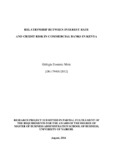| dc.description.abstract | Over the last 14 years, the Kenyan banking sector has been the subject of national interest due to
high interest rates charged on loans and high rates of loan defaults. Responding to the situation, the
Central Bank of Kenya, which is the industry's regulator, has over the years instituted a number of
policies that have been aimed at stabilising the market. This includes the Kenya Bankers' Rate
(KBR) that was introduced in July 2014 to serve as the industry's common reference point when
determining interest rates.
The objective of this study was to find out whether there exists a relationship between interest rate
and credit risk in commercial banks in Kenya. The study involved collecting secondary data from
Central Bank of Kenya for the prevailing interest rates and non-performing loans (NPLs) over the
period between 2000 and 2013. The data was then analysed using SPSS and results presented in
graphs and regressions.
The results showed that there was a significant relationship (68.7%) between interest rates and
credit risk in commercial banks in Kenya. This study also found out that there could be a host of
other factors that are responsible for the credit risk in Kenyan commercial banks. The study therefore
recommends further studies to be carried out on other variables which could be responsible for the
credit risk. This includes the pace of judicial processes and internal efficiencies in banks. | en_US |

